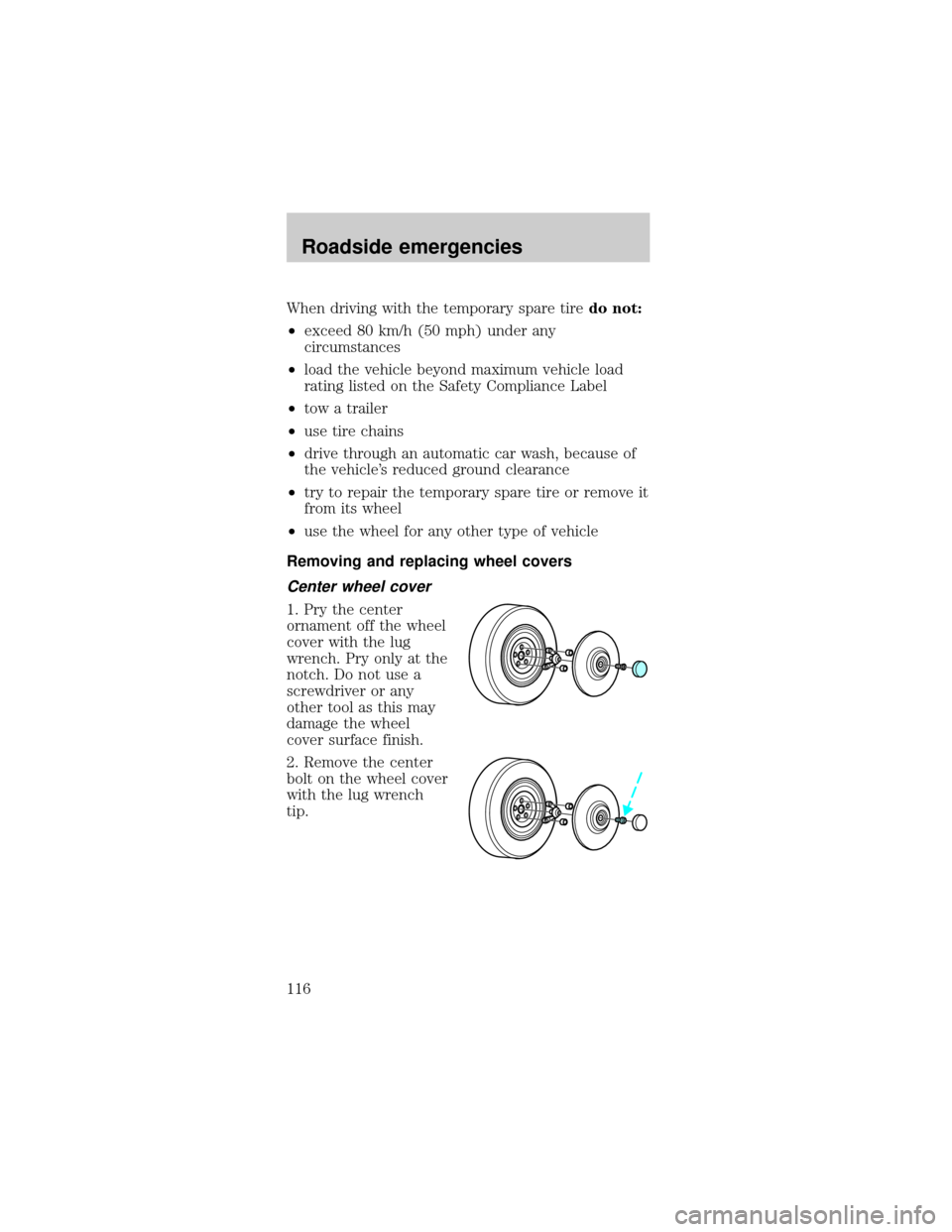tow Mercury Sable 1998 s Owner's Guide
[x] Cancel search | Manufacturer: MERCURY, Model Year: 1998, Model line: Sable, Model: Mercury Sable 1998Pages: 190, PDF Size: 1.29 MB
Page 105 of 190

Do not connect a trailer's hydraulic brake
system directly to your vehicle's brake
system. Your vehicle may not have enough braking
power and your chances of having a collision
greatly increase.
The braking system of the tow vehicle is rated for
operation at the GVWR not GCWR.
Trailer lamps
Trailer lamps are required on most towed vehicles.
Make sure your trailer lamps conform to local and
Federal regulations. See your dealer or trailer rental
agency for proper instructions and equipment for
hooking up trailer lamps.
Driving while you tow
Do not drive faster than 88 km/h (55 mph) when
towing a trailer. Do not drive faster than 72 km/h
(45 mph) with any weight on the trailer while
towing on a hot day or in hilly country.
Speed control may shut off if you are towing on
long, steep grades.
When towing a trailer:
²Use D (Drive) or a lower gear when towing up or
down steep hills. This will eliminate excessive
downshifting and upshifting for optimum fuel
economy and transaxle cooling.
²Anticipate stops and brake gradually.
Driving
105
Page 106 of 190

Servicing after towing
If you tow a trailer for long distances, your vehicle
will require more frequent service intervals. Refer to
the Severe Duty Schedule in your ªService Guideº
for more information.
Trailer towing tips
²Practice turning, stopping and backing up in an
area before starting on a trip to get the feel of the
vehicle trailer combination. When turning, make
wider turns so the trailer wheels will clear curbs
and other obstacles.
²Allow more distance for stopping with a trailer
attached.
²The trailer tongue weight should be 10±15% of
the loaded trailer weight.
²After you have traveled 80 km (50 miles),
thoroughly check your hitch, electrical
connections and trailer wheel lug nuts.
²When stopped in traffic for long periods of time in
hot weather, place the gearshift in P (Park) and
increase idle speed. This aids engine cooling and
air conditioner efficiency.
²Vehicles with trailers should not be parked on a
grade. If you must park on a grade, place wheel
chocks under the trailer's wheels.
Driving
106
Page 107 of 190

Towing your vehicle behind another vehicle
At times, you may want to tow your vehicle behind
another vehicle, such as a recreational vehicle, car
or a truck.
Before you have your vehicle towed:
²Release the parking brake.
²Move the gearshift to N (Neutral).
²Turn the key in the ignition to OFF.
²Unlock the steering wheel.
Do not tow your vehicle at a speed faster than 56
km/h (35 mph) or for a distance greater than 80 km
(50 miles), unless the drive wheels are placed on
dollies.
Never use a tow bar that attaches to the
bumper when you tow your vehicle. This
could damage the bumper and cause an accident.
LUGGAGE RACK (IF EQUIPPED)
The rear crossbar can be adjusted to fit the item
being carried. The front crossbar does not move. Do
not load more than 44 kg (100 lbs.) on the luggage
rack.
To adjust cross-bar position:
1. Loosen the
thumbwheel at both
ends of the cross-bar.
2. Slide the cross-bar
to the desired location.
3. Tighten the thumbwheel at both ends of the
cross-bar.
Use adjustable tie down loops to secure the load.
Driving
107
Page 116 of 190

When driving with the temporary spare tiredo not:
²exceed 80 km/h (50 mph) under any
circumstances
²load the vehicle beyond maximum vehicle load
rating listed on the Safety Compliance Label
²tow a trailer
²use tire chains
²drive through an automatic car wash, because of
the vehicle's reduced ground clearance
²try to repair the temporary spare tire or remove it
from its wheel
²use the wheel for any other type of vehicle
Removing and replacing wheel covers
Center wheel cover
1. Pry the center
ornament off the wheel
cover with the lug
wrench. Pry only at the
notch. Do not use a
screwdriver or any
other tool as this may
damage the wheel
cover surface finish.
2. Remove the center
bolt on the wheel cover
with the lug wrench
tip.
Roadside emergencies
116
Page 126 of 190

WRECKER TOWING
If you need to have your vehicle towed, contact a
professional towing service or, if you are a member,
your roadside assistance center.
It is recommended that your vehicle be towed with a
wheel lift or flatbed equipment.
A towing manual is available from Ford Motor
Company for all authorized tow truck operators.
Have your tow truck driver refer to this manual for
proper hook-up and towing procedures for your
vehicle.
Roadside emergencies
126
Page 148 of 190

Changing the wiper blades
To replace the wiper blades:
1. Pull the wiper arm
away from the
windshield and lock
into the service
position.
2. Turn the blade at an
angle from the wiper
arm. Push the lock pin
manually to release the
blade and pull the
wiper blade down
toward the windshield
to remove it from the arm.
3. Attach the new wiper to the wiper arm and press
it into place until a click is heard.
INFORMATION ABOUT TIRE QUALITY GRADES
New vehicles are fitted
with tires that have
their Tire Quality
Grade (described
below) molded into the
tire's sidewall. These
Tire Quality Grades are
determined by
standards that the
United States Department of Transportation has set.
Tire Quality Grades apply to new pneumatic tires for
use on passenger cars. They do not apply to deep
tread, winter-type snow tires, space-saver or
temporary use spare tires, tires with nominal rim
diameters of 10 to 12 inches or limited production
tires as defined in Title 49 Code of Federal
Regulations Part 575.104(c)(2).
U.S. Department of Transportation-Tire quality
grades:The U.S. Department of Transportation
requires Ford to give you the following information
Maintenance and care
148
Page 170 of 190

Cleaning plastic exterior parts
Use vinyl cleaner for routine cleaning. Clean with a
tar remover if necessary. Do not clean plastic parts
with thinners, solvents or petroleum-based cleaners.
Cleaning the exterior lamps
Wash with the same detergent as the exterior of
your vehicle. Use glass cleaner or tar remover if
necessary.
To avoid scratching the lamps, do not use a dry
paper towel, chemical solvents or abrasive cleaners.
Cleaning the wiper blades and windshield
If the wiper blades do not wipe properly, clean the
wiper blade rubber element with undiluted
windshield washer solution or a mild detergent. To
avoid damaging the blades, do not use fuel,
kerosene, paint thinner or other solvents.
If the wiper still does not wipe properly, this could
be caused by substances on the windshield such as
tree sap and some hot wax treatments used by
commercial car washes. Clean the outside of the
windshield with a non-abrasive cleanser such as the
non-abrasive Bon-Amitpowder. Rinse thoroughly
with clean water.Do notuse abrasive cleansers on
glass as they may cause scratches. The windshield is
clean if beads do not form when you rinse it with
water. The windshield and wiper blades should be
cleaned on a regular basis, and blades or rubber
elements replaced when worn.
Cleaning the instrument panel
Clean with a damp cloth, then dry with a dry cloth.
Avoid cleaner or polish that increases the gloss of
the upper portion of the instrument panel. The dull
finish in this area helps protect the driver from
undesirable windshield reflection.
Maintenance and care
170
Page 180 of 190

IDENTIFYING YOUR VEHICLE
Safety compliance label
The National Highway
Traffic Safety
Administration
Regulations require
that a Safety
Compliance
Certification Label be
affixed to a vehicle and
prescribe where the
Safety Compliance
Certification Label may
be located. The Safety Compliance Certification
Label is located on the front door latch pillar on the
driver's side.
Vehicle identification number
The vehicle
identification number
is attached to a metal
tag and is located on
the driver side
instrument panel.
Engine number
The engine number (the last eight numbers of the
vehicle identification number) is stamped on the
engine block, transmission, frame and transfer case
(if equipped).
MFD. BY FORD MOTOR CO. IN U.S.A.
EXT PNT: XXXXXX XXXXXX RC: XX DSO: XXXX F0000
BAR INT TR TP/PS R AXLE TR SPR T0000
X XX XXX X XX X XXXX
UTC
ÑFOHT-15294A10-GA
MAXIMUM LOAD=OCCUPANTS + LUGGAGE=XXXKG/XXXXLB
OCCUPANTS: X TOTAL X FR X 2ND X RR OCCUPANTS LUGGAGE
XX XXXKG/XXXXLB
TIRE: XXXX/XXXXX XXX X XXXKG/XXXXLB
PRESSURE (FR) XXX kPa/33 PSI COLD
PRESSURE (RR) XXX kPa/33 PSI COLD
TRAILER TOWING - SEE OWNER GUIDE
DATE: XXXXX GVWR:XXXXX LB/ XXXXX KG
VIN: XXXXXXXXXXXXXXXXX TYPE: XXXXXXXXXXXXXXX FGAWR: XXXXXX/XXXXXXX RGAWR: XXXXXXX/XXXXXXXTHIS VEHICLE CONFORMS TO ALL APPLICABLE FEDERAL
MOTOR VEHICLE SAFETY STANDARDS IN EFFECT ON THE
DATE OF MANUFACTURE SHOWN ABOVE.
XXXXXXXXXXXXXXXXXAIR BAG
Capacities and specifications
180
Page 184 of 190

Parking brake ............ 91
Power distribution box
(see Fuses) ............. 112
Power door locks ...... 36
Power steering .......... 92
fluid, checking and
adding ............. 138,139
Relays ............... 109,115
Remote entry system 43
illuminated entry .... 45
locking/unlocking
doors ................... 43,44
replacement/additional
transmitters ............. 45
replacing the
batteries .................. 46
Safety restraints ........ 62
cleaning the safety
belts .................. 66,172
extension
assembly .................. 64
for children ........ 72,73
lap belt ............... 61,62
warning light and
chime .................. 11,65
Seat belts (see Safety
restraints) ... 57,58,59,60
Seats .......................... 54
child safety seats .... 74
cleaning .......... 171,172
Servicing your
vehicle ...................... 127
Spark plugs,
specifications ........... 173
Specification chart,
lubricants ................. 175
Speed control ............ 28
Speedometer ............. 12
Starting your
vehicle .............. 84,85,86jump
starting .... 121,122,124
Steering wheel
tilting ....................... 33
Tires .................. 148,150
changing ................ 118
checking the
pressure ................. 150
replacing ................ 151
rotating .................. 151
snow tires an
d chains ................. 152
treadwear .............. 149
Towing
wrecker .................. 126
Transaxle
fluid, refill
capacities ............... 174
Transmission ........... 140
fluid, checking and
adding
(automatic) .... 140,141
Trip odometer ........... 14
Trunk
remote releas
e lever ...................... 40
Vehicle dimensions . 177
Vehicle Identification
Number (VIN) ......... 180
Vehicle loading ........ 100
Ventilating your
vehicle ........................ 88
Warning chimes ........... 6
Washer fluid ............ 134
Wheels
anti-theft lug
nuts ................. 117,118
Windows ............... 35,36
rear wiper/washer ... 32
Index
184